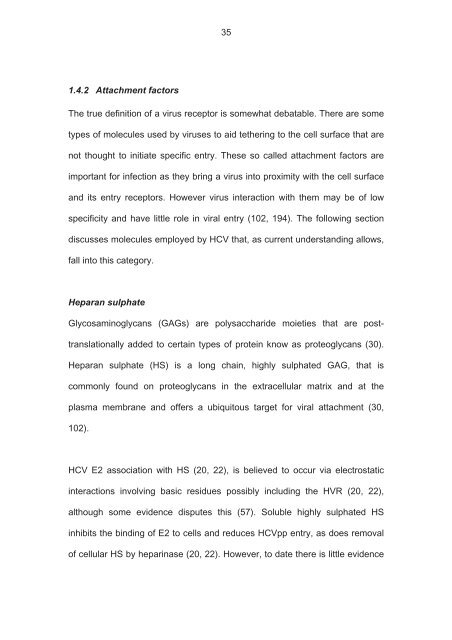The role of scavenger receptor BI in hepatitis - eTheses Repository ...
The role of scavenger receptor BI in hepatitis - eTheses Repository ...
The role of scavenger receptor BI in hepatitis - eTheses Repository ...
You also want an ePaper? Increase the reach of your titles
YUMPU automatically turns print PDFs into web optimized ePapers that Google loves.
1.4.2 Attachment factors<br />
35<br />
<strong>The</strong> true def<strong>in</strong>ition <strong>of</strong> a virus <strong>receptor</strong> is somewhat debatable. <strong>The</strong>re are some<br />
types <strong>of</strong> molecules used by viruses to aid tether<strong>in</strong>g to the cell surface that are<br />
not thought to <strong>in</strong>itiate specific entry. <strong>The</strong>se so called attachment factors are<br />
important for <strong>in</strong>fection as they br<strong>in</strong>g a virus <strong>in</strong>to proximity with the cell surface<br />
and its entry <strong>receptor</strong>s. However virus <strong>in</strong>teraction with them may be <strong>of</strong> low<br />
specificity and have little <strong>role</strong> <strong>in</strong> viral entry (102, 194). <strong>The</strong> follow<strong>in</strong>g section<br />
discusses molecules employed by HCV that, as current understand<strong>in</strong>g allows,<br />
fall <strong>in</strong>to this category.<br />
Heparan sulphate<br />
Glycosam<strong>in</strong>oglycans (GAGs) are polysaccharide moieties that are post-<br />
translationally added to certa<strong>in</strong> types <strong>of</strong> prote<strong>in</strong> know as proteoglycans (30).<br />
Heparan sulphate (HS) is a long cha<strong>in</strong>, highly sulphated GAG, that is<br />
commonly found on proteoglycans <strong>in</strong> the extracellular matrix and at the<br />
plasma membrane and <strong>of</strong>fers a ubiquitous target for viral attachment (30,<br />
102).<br />
HCV E2 association with HS (20, 22), is believed to occur via electrostatic<br />
<strong>in</strong>teractions <strong>in</strong>volv<strong>in</strong>g basic residues possibly <strong>in</strong>clud<strong>in</strong>g the HVR (20, 22),<br />
although some evidence disputes this (57). Soluble highly sulphated HS<br />
<strong>in</strong>hibits the b<strong>in</strong>d<strong>in</strong>g <strong>of</strong> E2 to cells and reduces HCVpp entry, as does removal<br />
<strong>of</strong> cellular HS by hepar<strong>in</strong>ase (20, 22). However, to date there is little evidence

















